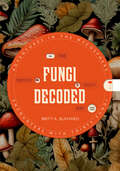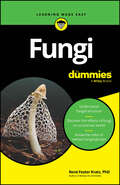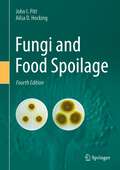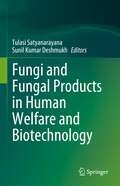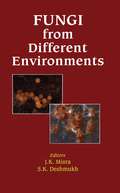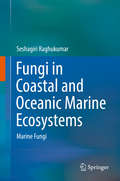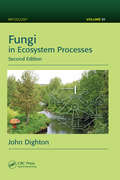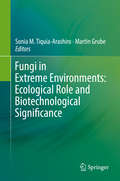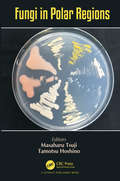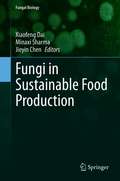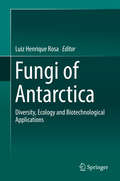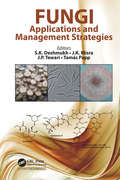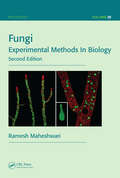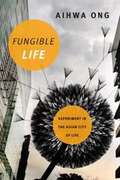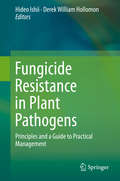- Table View
- List View
Fungi Collected in Shropshire and Other Neighbourhoods: A Victorian Woman's Illustrated Field Notes
by M. F. LewisVenture into the woods alongside a pioneering female mycologist. This one-of-a-kind, keepsake volume celebrates the timeless fascination of fungi.Very little is known about M. F. Lewis—not even her first name. Mysterious, prolific, and deeply enamored with the world of mushrooms, she left us a treasure trove of mycological illustrations. For over forty years, from 1860 to 1902, Lewis rambled across England and Wales, recording an astonishing biodiversity of fungi. Her delicately drawn, boldly colored images evoke the strange and powerful beauty of this kingdom. This handsome volume collects hundreds of Lewis's watercolors, contextualized by a foreword from mycologist Dr. Patricia Ononiwu Kaishian. It's a must-have for today's mushroom lovers who are curious about the history of mycology and for any admirer of vintage botanical illustration who wants to discover something different.FASCINATING FUNGI: Mushrooms are having a real moment, but they've always captured our imaginations, even in Victorian times. Lewis's gorgeous artwork offers the modern mushroom fan a new way to appreciate their favorite kingdom.VINTAGE AESTHETIC: This lovely clothbound volume evokes the magic of uncovering a treasure in a jumbled vintage bookstore. FEMINIST HISTORY: While little is known of the elusive M. F. Lewis, we can celebrate the legacy that she and other female naturalists of the 19th century left for women in science and art today.ARTFUL SCIENCE: Lewis's illustrated field notes showcase the intersection of art and science at its best.Perfect for:Mushroom hunters, eaters, and admirersFans of cottagecore and goblincore aestheticsCollectors of vintage books and vintage botanical illustrationCollectors of Victorian ephemeraReaders of feminist historyEnvironmentalists, scientists, and artists
Fungi Decoded: Adventures in the Mycosphere--Encounters with Thirty Fungi
by Britt A. BunyardA visual celebration of the Fungus Kingdom, offering an accessible introduction to mycology in its first half before diving into 30 profiles of diverse and astonishing mushrooms.Informed by the latest research, and mycologist Britt Bunyard&’s decades-long relationship with fungi across the globe, Fungi Decoded offers a tour of the world's most intriguing mushrooms, spotlighting well-known fungi such as the Fly Agaric as well as morphological oddities such as Stinkhorns and Bird&’s Nest Fungi. Through in-depth profiles on thirty mushrooms, you will learn about a variety of morphogroups, distributions, habitats, and substrate types. This book also explores the most intriguing questions at the heart of these extraordinarily strange organisms. What makes some fungi glow? Which fungi strangle nematodes? How have fungi changed the course of human history? What happens if you step into a fairy ring of mushrooms? Why do some fungi grow in dung?Featuring vivid illustrations and filled with fascinating information, Fungi Decoded is perfect for both new fungus fans and seasoned mycophiles.Note: This book is not meant for identifying edible mushrooms.
Fungi For Dummies
by Rene Fester KratzDiscover the fundamentals of fungi with this engaging and easy-to-follow book Fungi For Dummies gives you an in-depth view of the wide world of mycology. With this science-focused yet clear and readable book, you'll dig deep into the science of the fascinating organisms that help this planet thrive. Learn about fungi classifications and structures, their uses in and beyond medicine, their importance to environmental sustainability, and how they have shaped human cultures around the world. Go beyond the typical mushroom field guide and get a thorough introduction to the study of mycology that tracks a typical undergraduate course in the field. Grasp the basics of mycology, including how fungi grow and how they differ from plants Discover the role fungi play in ecosystems around the world Learn to classify the different biological structures that appear in fungi Know the various fungal groups and their roles in nature and in human endeavors Perfect for those who want or need to get a grasp on mycology, Fungi For Dummies is an approachable introduction to this essential organism group.
Fungi and Food Spoilage
by John I. Pitt Ailsa D. HockingThis is the third edition of the definitive work on fungi in foods covering identification, isolation, enumeration, taxonomy, physiology and mycotoxin formation. High quality halftones provide a book of great value to food microbiologists, mycologists, food scientists and technologists and all those involved in food quality and safety.
Fungi and Food Spoilage
by John I. Pitt Ailsa D. HockingThe first three editions of Fungi and Food Spoilage established, then consolidated, a reputation as the leading book on foodborne fungi. It details media and methods for isolation and identification, descriptions of species, and information on their physiology, ecology and mycotoxin formation. It is an invaluable reference for food microbiologists investigating fungal food spoilage problems, both in field crops and processed foods, and the likelihood of mycotoxin production in either.The Fourth Edition incorporates major differences from the Third: multiple changes in nomenclature due to changes in the International Code of Nomenclature for algae, fungi and plants; many taxonomic changes due to improvements in, and more widespread application of, molecular methods in taxonomy; the introduction of colour colony photographs where appropriate; and a new chapter on mycotoxins.The introductory chapters of the book deal with the ecology of food spoilage, and provide an overview of how food processing, packaging and storage parameters influence fungal growth. A subsequent chapter overviews the fundamentals of naming and classifying fungi. Morphological methods and media suitable for low cost and effective isolation, enumeration and identification of foodborne fungi are provided, together with many more specialised media and techniques. The major part of the book provides keys, descriptions and illustrations of all yeasts and filamentous fungi commonly encountered in foods. Other known characteristics of the species, including physiology and ecology are included. Chapters on the types and species of fungi likely to be found in fresh, harvested and variously processed foods are followed by a new chapter on mycotoxins, both major and minor, their sources, both fungal and food, and their implications for human health.The broad and practical nature of the coverage will appeal to microbiologists, mycologists and biotechnologists in the food industry, as well scientists in academic, research and public health institutions.Drs Pitt and Hocking worked for CSIRO Food for more than 100 years combined. Both are now retired from CSIRO: Dr Pitt continues to work part time with Microbial Screening Technologies, a biodiscovery company.
Fungi and Fungal Products in Human Welfare and Biotechnology
by Tulasi Satyanarayana Sunil Kumar DeshmukhThis book presents various biotechnological applications of the fungal systems in pharmaceuticals, nutraceuticals, textile industry, bioremediation, biofuel, and the production of biomolecules. It discusses the important role of fungal secondary metabolites in human welfare and nutrition. It explores fungi as the vital sources of novel substances with antidiabetic, antibiotic as well as prebiotic properties. The book further describes the natural and unique ability of fungi to biodegrade macro- and microplastics by using them as a source of carbon and energy. Notably, it presents the properties and applications of bioactive fungal polysaccharides and discusses the latest developments in utilizing these biopolymers in human nutrition. In addition, the book examines the production of biodegradable and sustainable natural colorants from fungal sources. This book is a valuable source for mycologists, biotechnologists, and microbiologists for understanding the important role of fungi in biotechnology.
Fungi and their Role in Sustainable Development: Current Perspectives
by Praveen Gehlot Joginder SinghThis book illustrates the multiple roles of fungi in everyday life. Fungi are the large group of organisms with tremendous diversity and economic importance. Their ability to produce commercially efficient useful products makes them the vulnerable sustainable tool for the future generation. This book describes a systems approach and provides a means to share the latest developments and advances about the benefits of fungi including their wide application, traditional uses, modern practices, along with designing of strategies to harness their potential. The chapters are organized with data, providing information related to different sustainable aspects of fungi in agriculture, its cultivation and conservation strategies, industrial and environmental utilization, advanced bioconversion technologies and modern biotechnological interventions. Updated information and current opinion related to its application for sustainable agriculture, environment, and industries as futuristic tools have been presented and discussed in different chapters. The book also elucidates a comprehensive yet a representative description of the challenges associated with the sustained application of fungi to achieve the goals of sustainability.
Fungi as Bioremediators
by Ajit Varma Ebrahim Mohammadi Goltapeh Younes Rezaee DaneshBiological remediation methods have been successfully used to treat polluted soils. While bacteria have produced good results in bioremediation for quite some time now, the use of fungi to decontaminate soils has only recently been established. This volume of Soil Biology discusses the potentials of filamentous fungi in bioremediation. Fungi suitable for degradation, as well as genetically modified organisms, their biochemistry, enzymology, and practical applications are described. Chapters include topics such as pesticide removal, fungal wood decay processes, remediation of soils contaminated with heavy and radioactive metals, of paper and cardboard industrial wastes, and of petroleum pollutants.
Fungi for Human Health: Current Knowledge and Future Perspectives
by Khalid Rehman Hakeem Uzma Azeem M. AliCurrent research lays emphasis on exploring natural products for use in nutraceuticals and pharmaceuticals to overcome various side effects of synthetic drugs. Fungi occupy an eminent position among natural sources of food and medicinal importance since ancient times. Many fungal species have been eaten as food and used in folk medicine for the treatment of many human ailments as mentioned in traditional medical literature. However, scanty information is available pertaining to the nutraceutical and pharmaceutical importance of fungi which merits an extensive review. This book spotlights the use value macrofungi in human health. Macrofungi with health benefitting properties largely belong to Basidiomycota followed by Ascomycota growing indoor (cultivated) and outdoor (wild). We endeavoured to throw light on the benefits of macrofungal taxa in relation to their food and medicinal significance in human life. We provided knowledge pertaining to the ethnomycological significance of macrofungi with respect to their uses as food and medicine by the people inhabiting different parts of the world. This book highlights the nutritional composition and bioactive compounds present in macrofungi. We also focused on the pharmacological activities of macrofungi contributing towards their medicinal value against several human disorders. We cited many commercially available nutraceutical and pharmaceutical products of macrofungal origin. This work will hopefully serve as a basic reference for general public, mycologists, researches and industry men, interested in consumption, research and marketing of macrofungi.
Fungi from Different Environments
by J. K. MisraMycologists now look at the genes of fungi to decipher many features that they have been studying in the past beyond just looking at the morphology and other such traits of these organisms. Fungi are also attracting the attention of scientists in various other disciplines. These include the search for useful fungi in various extreme environments th
Fungi in Biogeochemical Cycles
by Geoffrey Michael GaddFungi play important roles in the cycling of elements in the biosphere but are frequently neglected within microbiological and geochemical research spheres. Symbiotic mycorrhizal fungi are responsible for major transformations and redistribution of inorganic nutrients, while free-living fungi have major roles in the decomposition of organic materials, including xenobiotics. Fungi are also major biodeterioration agents of stone, wood, plaster, cement and other building materials, and are important components of rock-inhabiting microbial communities. The aim of this 2006 book is to promote further understanding of the key roles that free-living and symbiotic fungi (in mycorrhizas and lichens) play in the biogeochemical cycling of elements, the chemical and biological mechanisms that are involved, and their environmental and biotechnological significance. Where appropriate, relationships with bacteria are also discussed to highlight the dynamic interactions that can exist between these major microbial groups and their integrated function in several kinds of habitat.
Fungi in Coastal and Oceanic Marine Ecosystems
by Seshagiri RaghukumarThis book offers an ecosystem-oriented overview of the diversity, ecological role, and biotechnological applications of marine fungi as well as an in-depth introduction to the marine environment, fungal classification, and ecological principles. It also presents the latest research findings on coastal marine and oceanic ecosystems, such as mangrove, seagrass, salt marsh, algal, coral reef and benthic ecosystems. Focusing on the diversity of fungi as well as their role as symbionts, parasites and saprotrophs, the book also discusses the physiology and biotechnological applications of fungi and highlights topics of future interest. Intended for students and researchers in marine biology and microbiology, it includes detailed descriptions, illustrations, figures, tables, and exhaustive literature citations. A detailed chapter on methods used to study marine fungi, their classification and ecological principles is of particular interest to newcomers in the field.
Fungi in Ecosystem Processes (Mycology #Vol. 17)
by John DightonThis new edition of Fungi in Ecosystem Processes continues the unique approach of examining the roles of fungi from the perspective of ecosystem functions. It explores how fungi have adapted to survive within particular constraints, how they help to maintain homeostasis in ecosystems, how they facilitate resistance to perturbations, and how they influence the communities of other organisms. Updated and revised, the second edition Expands the section on plant pathogens, invasive species, and insect–fungal interactions Provides more extensive coverage on insect–fungal interactions, including entomopathogens, the links between entomopathogens and endophytes, and symbiotic and mutualistic interactions Adds a new section on fungi in the built environment Presents new material on below-ground to above-ground interactions mediated through fungi, such as mycorrhizal signaling systems for herbivory defense The book also includes expanded coverage of the role of fungi in suppressive soils, aquatic and marine fungi, modern methods of following food chains in fungal–invertebrate trophic interactions, and the physiology of nutrient uptake by mycorrhizae. A necessary update and expansion to previous material, this book provides an essential reference on the current understanding of fungal roles in ecosystem processes. It also identifies directions for future study, including an emphasis on the need for further research on fungi in built environments.
Fungi in Extreme Environments: Ecological Role and Biotechnological Significance
by Martin Grube Sonia M. Tiquia–ArashiroOver the last decades, scientists have been intrigued by the fascinating organisms that inhabit extreme environments. These organisms, known as extremophiles, thrive in habitats which for other terrestrial life-forms are intolerably hostile or even lethal. Based on such technological advances, the study of extremophiles has provided, over the last few years, ground-breaking discoveries that challenge the paradigms of modern biology. In the new bioeconomy, fungi in general, play a very important role in addressing major global challenges, being instrumental for improved resource efficiency, making renewable substitutes for products from fossil resources, upgrading waste streams to valuable food and feed ingredients, counteracting life-style diseases and antibiotic resistance through strengthening the gut biota, making crop plants more robust to survive climate change conditions, and functioning as host organisms for production of new biological drugs. This range of new uses of fungi all stand on the shoulders of the efforts of mycologists over generations. The book is organized in five parts: (I) Biodiversity, Ecology, Genetics and Physiology of Extremophilic Fungi, (II) Biosynthesis of Novel Biomolecules and Extremozymes (III) Bioenergy and Biofuel synthesis, and (IV) Wastewater and biosolids treatment, and (V) Bioremediation.
Fungi in Fuel Biotechnology (Fungal Biology)
by Meisam Tabatabaei Mortaza Aghbashlo Gholamreza Salehi JouzaniDue to the huge quantity and diverse nature of their metabolic pathways, fungi have great potential to be used for the production of different biofuels such as bioethanol, biobutanol, and biodiesel. This book presents recent advances, as well as challenges and promises, of fungal applications in biofuel production, subsequently discussing plant pathogenic fungi for bioethanol and biodiesel production, including their mechanisms of action. Additionally, this book reviews biofuel production using plant endophytic fungi, wood-rotting fungi, fungal biocontrol agents, and gut fungi, and it investigates highly efficient fungi for biofuel production and process design in fungal-based biofuel production systems. Finally, life cycle assessment of fungal-based biofuel production systems are discussed in this volume.
Fungi in Polar Regions
by Masaharu Tsuji Tamotsu HoshinoFungi that inhabit polar-region can grow and decompose organic compounds under subzero temperatures play important roles in the nutrient cycle of polar-region ecosystems. Thus, changes in the mycoflora affect the ecological recycling in these regions, and understanding the cold-adaptation strategies of fungi under extreme environments is critical for a better understanding of polar-region ecosystems. Due to their ability to survive under extreme environments, fungi in polar-region are seen to show potential for utilization in biotechnologies. This book presents our current understanding of the mycoflora in polar-region and their cold adaptation strategies, and applied studies using their abilities.
Fungi in Sustainable Food Production (Fungal Biology)
by Xiaofeng Dai Minaxi Sharma Jieyin ChenThis book presents research on the challenges and potential of fungal contribution in agriculture for food substantiality. Research on fungi plays an essential role in the improvement of biotechnologies which lead global sustainable food production. Use of fungal processes and products can bring increased sustainability through more efficient use of natural resources. Fungal inoculum, introduced into soil together with seed, can promote more robust plant growth through increasing plant uptake of nutrients and water, with plant robustness being of central importance in maintaining crop yields. Fungi are one of nature′s best candidates for the discovery of food ingredients, new drugs and antimicrobials. As fungi and their related biomolecules are increasingly characterized, they have turned into a subject of expanding significance. The metabolic versatility makes fungi interesting objects for a range of economically important food biotechnology and related applications. The potential of fungi for a more sustainable world must be realized to address global challenges of climate change, higher demands on natural resources.
Fungi of Antarctica: Diversity, Ecology and Biotechnological Applications
by Luiz Henrique RosaThis book focuses on the fungi found in one of the most pristine regions on Earth: Antarctica. It discusses the fungal occurrence in all substrates of the region, including soil, seawater, lake and marine sediments, rocks, ice, and snow. It also addresses the impact of climate changes on these organisms, the genomic techniques developed to study them, and how a number of compounds, such as antibiotics and enzymes, produced by the Antarctic fungi can be used in medicine, agriculture and the chemical industry.
Fungi, Fungi, Everywhere!
by Gail JarrowWhat comes to mind with you think of fungi? Is it mushrooms, or perhaps mildew? Mold and yeast are fungi, too! Learn all about how fungi reproduce with spores, and how their bodies are made up of mycelium!
Fungi: Applications and Management Strategies (Progress in Mycological Research #3)
by Sunil K. Deshmukh J. K. Misra Jalpa P. Tewari Tamas PappThe book deals with the application of fungi and the strategic management of some plant pathogens. It covers fungal bioactive metabolites, with emphasis on those secondary metabolites that are produced by various endophytes, their pharmaceutical and agricultural uses, regulation of the metabolites, mycotoxins, nutritional value of mushrooms, prospecting of thermophilic and wood-rotting fungi, and fungi as myconano factories. Strategies for the management of some plant pathogenic fungi of rice and soybean have also been dealt with. Updated information for all these aspects has been presented and discussed in different chapters.
Fungi: Biology and Applications
by Kevin KavanaghThis newly updated edition covers a wide range of topics relevant to fungal biology, appealing to academia and industry Fungi are extremely important microorganisms in relation to human and animal wellbeing, the environment, and in industry. The latest edition of the highly successful Fungi: Biology and Applications teaches the basic information required to understand the place of fungi in the world while adding three new chapters that take the study of fungi to the next level. Due to the number of recent developments in fungal biology, expert author Kevin Kavanagh found it necessary to not only update the book as a whole, but to also provide new chapters covering Fungi as Food, Fungi and the Immune Response, and Fungi in the Environment. Proteomics and genomics are revolutionizing our understanding of fungi and their interaction with the environment and/or the host. Antifungal drug resistance is emerging as a major problem in the treatment of fungal infections. New fungal pathogens of plants are emerging as problems in temperate parts of the world due to the effect of climate change. Fungi: Biology and Applications, Third Edition offers in-depth chapter coverage of these new developments and more—ultimately exposing readers to a wider range of topics than any other existing book on the subject. Includes three new chapters, which widen the scope of fungi biology for readers Takes account of recent developments in a wide range of areas including proteomics and genomics, antifungal drug resistance, medical mycology, physiology, genetics, and plant pathology Provides extra reading at the end of each chapter to facilitate the learning process Fungi: Biology and Applications is designed for undergraduate students, researchers, and those working with fungi for the first time (postgraduates, industrial scientists).
Fungi: Experimental Methods In Biology, Second Edition (Mycology)
by Ramesh MaheshwariFungi are now at the forefront of research on mechanisms in gene silencing, biological rhythm, mating processes, biogenesis of intracellular organelles, adaptations to hostile habitats, structure of natural populations, and speciation. Because of their small genomes, fungi are being used in "systems biology" to understand the connections between ge
Fungible Life: Experiment in the Asian City of Life
by Aihwa OngIn Fungible Life Aihwa Ong explores the dynamic world of cutting-edge bioscience research, offering critical insights into the complex ways Asian bioscientific worlds and cosmopolitan sciences are entangled in a tropical environment brimming with the threat of emergent diseases. At biomedical centers in Singapore and China scientists map genetic variants, disease risks, and biomarkers, mobilizing ethnicized "Asian" bodies and health data for genomic research. Their differentiation between Chinese, Indian, and Malay DNA makes fungible Singapore's ethnic-stratified databases that come to "represent" majority populations in Asia. By deploying genomic science as a public good, researchers reconfigure the relationships between objects, peoples, and spaces, thus rendering "Asia" itself as a shifting entity. In Ong's analysis, Asia emerges as a richly layered mode of entanglements, where the population's genetic pasts, anxieties and hopes, shared genetic weaknesses, and embattled genetic futures intersect. Furthermore, her illustration of the contrasting methods and goals of the Biopolis biomedical center in Singapore and BGI Genomics in China raises questions about the future direction of cosmopolitan science in Asia and beyond.
Fungicide Resistance in Plant Pathogens
by Hideo Ishii Derek William HollomonThis volume offers a comprehensive coverage of the general principles and recent advances in fungicide resistance. It describes the development, mechanisms, monitoring, and management of resistance and covers the most important group of fungicides that have caused resistance on various crops. An historical review of fungicide resistance over the past 40 years sets the scene for up-to-date basic information on mode of action, as well as the genetics, mechanisms, and evolution of resistance. Monitoring for resistance, including the latest developments in molecular diagnostics, moves readers into the practical aspects of resistance management, which is dealt with through a series of case studies outlining fungicide-use strategies on several key crops. The chapters reflect the experience of authors internationally recognised for their significant contributions to fungicide resistance research. The majority of crop diseases are caused by fungal pathogens, and disease control relies heavily on chemically synthesized fungicides. However, modern fungicides often encounter the problem of resistance development in target pathogens. Thus pathogen resistance to fungicides is an important factor that causes loss of yield and quality of crops. It often threatens biosecurity through the decrease of fungicide efficacy in the fields. To manage fungicide resistance successfully will require the promotion of integrated disease management, involving not just chemical fungicides, but also host plant resistance, agronomic factors, and reliable biological control agents where these are available. Well referenced throughout, the book offers a comprehensive account of resistance, which will be useful as a source of material for lecturers and for both industrial and academic scientists involved in fungicide resistance research. It is also a valuable sourcebook for students.
Fungicides in Practice
by Richard P. Oliver Professor Janna L BeckermanThis is an up-to-date guide on the science and practice of disease control based on fungicides in horticulture and broad acre agriculture. It describes how conventional, organic and biological fungicides are discovered, how they work and how resistance evolves. Chapters on formulation, mode of action, mobility and application inform decisions about which fungicides to use, when to use them, and how to rotate (or tank-mix) them, to manage both plant disease and fungicide resistance. A chapter on experimental design of fungicide trials aids practitioners in designing their own trials to evaluate how effective products are for their plant disease problem. Based on the successful 2014 book of Fungicides in Crop Protection this edition has four entirely new chapters, and extensive updates to the other nine chapters. The contents include: · Fungicide markets, discovery and performance. · Modes of action and spectrum. · Biological crop protection, and organic cultivation. · Fungicide formulation, mobility and application. · Experimental design of fungicide trials and their analysis. · Fungicide resistance. · Legislation and regulation. Written for crop protection professionals and scientists, growers, agronomists and consultants, the book is also suitable for students of agriculture and agronomy.

